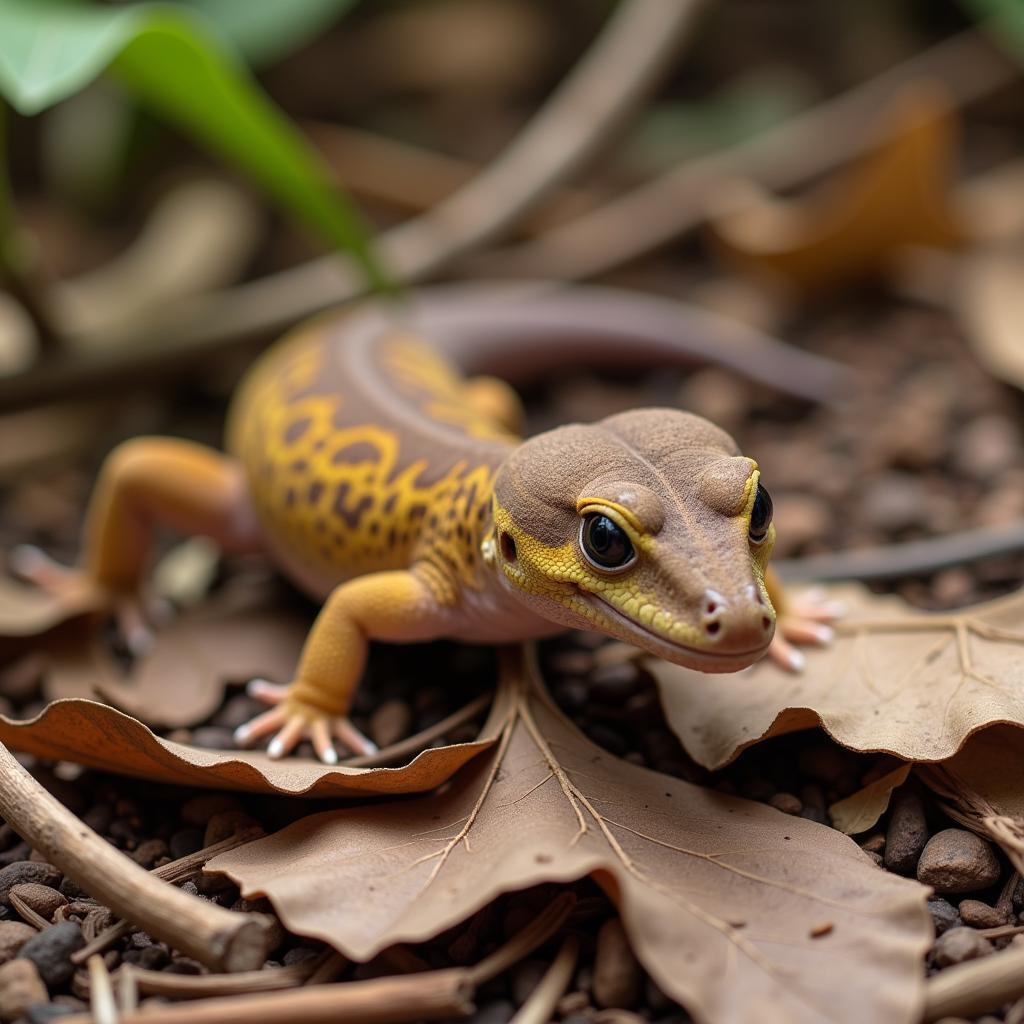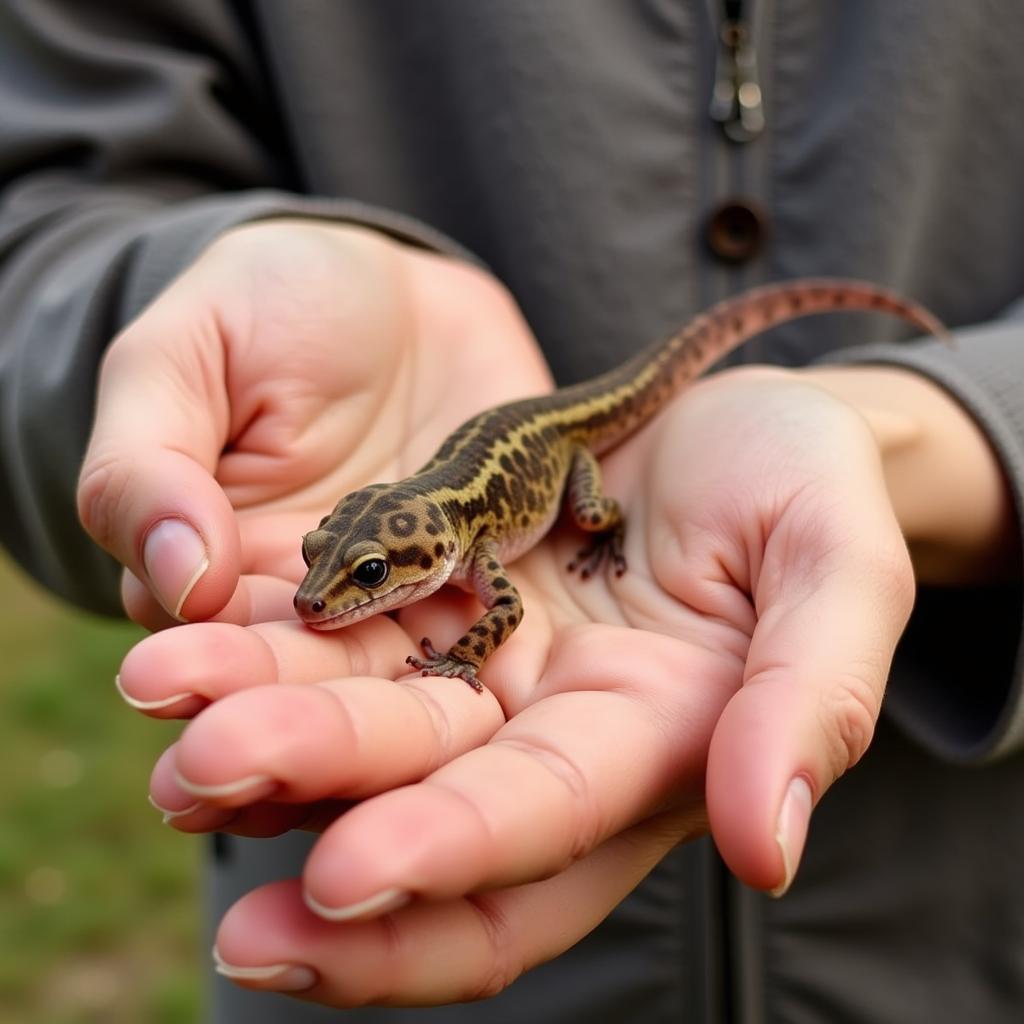The African Fat-Tailed Gecko: Your Comprehensive Guide to “E”
The African fat-tailed gecko, affectionately nicknamed the “fat-tail” or simply “E”, is a fascinating creature gaining popularity in the world of reptile enthusiasts. Native to West Africa, these gentle and relatively easy-to-care-for geckos are a great option for both beginner and experienced reptile owners. This guide will provide you with all the information you need to know about the African fat-tailed gecko, from their unique characteristics to their care requirements.
Understanding the African Fat-Tailed Gecko
African fat-tailed geckos (Hemitheconyx caudicinctus) are small, nocturnal lizards known for their docile nature and, as their name suggests, their distinctively thick tails. These geckos are typically brown or tan with lighter banding patterns, providing excellent camouflage in their natural habitat.
 African Fat-Tailed Gecko Blending In
African Fat-Tailed Gecko Blending In
Size and Lifespan
These adorable geckos typically reach an adult size of 7-9 inches, with females being slightly smaller than males. With proper care, African fat-tailed geckos can live for 15-20 years, making them a long-term commitment for any potential owner.
Temperament and Handling
“E” is known for their calm and gentle personality. Unlike some gecko species, they are not prone to biting and generally tolerate handling well, making them a good choice for families with children. However, it’s important to handle them with care and avoid tail pulling, as they can drop their tails as a defense mechanism.
 Gently Handling an African Fat-Tailed Gecko
Gently Handling an African Fat-Tailed Gecko
Creating the Perfect Home for Your African Fat-Tailed Gecko
Providing a suitable habitat is crucial for the well-being of your African fat-tailed gecko.
Enclosure
A 10-gallon tank is sufficient for a single gecko, while a larger enclosure is necessary for pairs or groups. These geckos are terrestrial, meaning they spend most of their time on the ground, so floor space is more important than height.
Substrate
Use a substrate that retains moisture, such as coconut fiber or cypress mulch, to maintain humidity levels. Avoid using sand or gravel, as these can cause impaction if ingested.
Temperature and Humidity
Maintain a temperature gradient within the enclosure, with a warm side around 85-90°F (29-32°C) and a cooler side around 75-80°F (24-27°C). A heat mat placed on one side of the enclosure is an effective way to create a basking spot. Humidity levels should be kept around 50-60%, which can be achieved by misting the enclosure daily.
Hiding Spots and Enrichment
Provide several hiding spots within the enclosure using rocks, caves, or commercially available reptile hides. Enrichment items like branches, cork bark, and plants can also be added to create a more stimulating environment.
Feeding Your African Fat-Tailed Gecko
“E” are insectivores, meaning their diet consists primarily of insects.
What to Feed
Crickets, mealworms, and dubia roaches are all excellent food choices. Offer a variety of insects to ensure a balanced diet.
How Often to Feed
Feed adult geckos 2-3 times per week, while juveniles should be fed daily.
Supplementation
Dust insects with a calcium and vitamin D3 supplement at every feeding to ensure proper bone health.
Common Questions About African Fat-Tailed Geckos
Here are answers to some frequently asked questions:
-
How can I tell if my African fat-tailed gecko is male or female? Males have noticeable femoral pores located on the underside of their hind legs, while females do not.
-
Do African fat-tailed geckos need UVB lighting? While not strictly necessary, providing a low-level UVB bulb can be beneficial for their overall health and well-being.
-
Why is my gecko’s tail so fat? Their tails serve as a fat storage organ, allowing them to survive periods of food scarcity.
-
Can I house multiple African fat-tailed geckos together? Yes, but avoid housing males together, as they can become territorial.
-
How often should I clean my gecko’s enclosure? Spot clean the enclosure daily and perform a full cleaning every 4-6 weeks.
Conclusion
The African fat-tailed gecko, or “E”, is an endearing and low-maintenance reptile that makes a wonderful pet. By following the care guidelines outlined in this comprehensive guide, you can provide your African fat-tailed gecko with a long, healthy, and enriching life.



